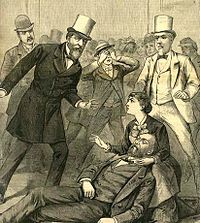On the early
morning hours of September 30, 1888, serial killer Jack the Ripper claimed two
victims in one night, Elizabeth Stride and Catherine Eddowes. Jack the Ripper is the name given to
an unidentified serial killer who was active in the Whitechapel district of
London in 1888.
The name
originated in a letter, written by someone claiming to be the murderer that was
disseminated in the media. The letter is widely believed to have been a hoax,
and may have been written by a journalist in a deliberate attempt to heighten
interest in the story. Attacks ascribed to the Ripper typically involved female
prostitutes who lived and worked in the slums of London and whose throats were
cut prior to abdominal mutilations. Extensive newspaper coverage bestowed
widespread and enduring international notoriety on the Ripper.
Stride's body was
discovered at about 1 a.m., in Dutfield's Yard, off
Berner Street in Whitechapel. The cause of death was one clear-cut incision
which severed the main artery on the left side of the neck. Witnesses who
thought they saw Stride with a man earlier that night gave differing
descriptions. Eddowes' body was found in Mitre Square, in the City of London,
three-quarters of an hour after Stride's. The throat was severed, and the
abdomen was ripped open by a long, deep, jagged wound. The left kidney and the
major part of the uterus had been removed. These murders were later called the
"double event.” Part of Eddowes' bloodied apron was found at the entrance
to a tenement in Goulston Street, Whitechapel. Some writing on the wall above
the apron piece, seemed to implicate a Jew or Jews, but it was unclear whether
the graffiti was written by the murderer as he dropped the apron piece, or
merely incidental. Police Commissioner Charles Warren feared the graffiti might
spark anti-Semitic riots, and ordered it washed away before dawn.
Michael Thomas Barry is a
columnist for CrimeMagazine.com and is the author of Murder & Mayhem 52 Crimes that
Shocked Early California
1849-1949. The book can be purchased from Amazon through the
following link:










